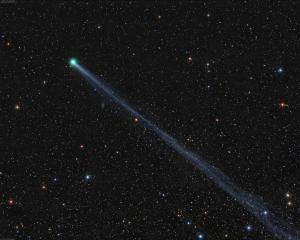Celebration of Space - May 22, 2020

An artists impression of the SpaceX Crew Dragon departing the International Space Station. Credit: SpaceX
This coming Wednesday, May 27, 2020 at 4:33 pm ET, the first crew supported launch from the United States to occur since the last launch of the Shuttle missions on July 8, 2011, is happening. This launch will occur on SpaceX hardware and will launch from NASA’s Kennedy Space Center in Florida. The launch vehicle is the Falcon 9 rocket, the crew capsule is the Crew Dragon module. The crew is comprised of two NASA astronauts, Robert Behnken, and Douglas Hurley. The destination of the launch is the International Space Station (ISS). Once docked with the ISS, both astronauts will join the Expedition 63 crew, and reside on the station for an undetermined duration. Once a departure date is established, both astronauts will debark the ISS on board the same Crew Dragon crew module, re-enter Earth’s atmosphere, and splash-down off the Florida Atlantic coast. This is certainly a historic event, though on NASA’s page you will have to tread through a lot of unnecessary nationalism (and typos) to actually find useful information about the launch. Thankfully SpaceX has quite an informative page, without all the rhetoric. NASA TV will broadcast the launch live, starting at 12:00 pm ET and continuing into the evening (the first launch window is 4:33 pm ET). In the meantime, catch up how this launch will play out. Thank you SpaceX for an informative page. NASA, what’s up?!
How about that comet that we have been boosting lately, the one that has finally entered the Northern Hemisphere sky without the interference of the Moon? That’s Comet C/2020 F8 SWAN, and it feels like the usual is starting to happen. First, there is something to keep in mind. The Northern Hemisphere is not positioned very well for comet viewing. This is because of the tilt of the planet, the solar system, and the galaxy; and how all that relates to each other. The Northern Hemisphere is just not it. As it goes for Comet SWAN, the Southern Hemisphere got the show, and the Northern Hemisphere appears to be left in the dust (no pun intended). The comet, which achieved naked eye visibility in late April / early May, has begun to fade. After a few outbursts, which significantly increased the comet’s brightness, the comet appears to be fizzling out quickly, and is no longer naked eye visible. Over the next week (May 26, 2020), comet SWAN will reach perihelion (its closest approach to the Sun). This could go one of two ways. We may see new volatile materials on the comet begin to heat up and out-gas, which could brighten the comet back up. Or the comet could break up, like Comet C/2019 Y4 Atlas did. It’s too early to tell what will happen, though the general consensus is that the comet will break up. Regardless, there is still a secondary rebound comet in the sky, Comet C/2019 U6 Lemmon. Comet Lemmon has also experienced an outburst and has significantly brightened. It is currently binocular visible and should continue to brighten as it approaches the Sun for its June 18, 2020 perihelion. Predicting a comet’s visibility is difficult, and usually predictions are very uncertain (as you can see). Will Comet SWAN spring back to life? We really don’t know, but post-perihelion can bring a whole new period of viewing opportunities, if the comet survives its encounter with the Sun. Here’s to hoping!
Evening passes of the International Space Station (ISS) over the US, specifically the Northeast, will continue this week. Though no spectacular passes are on the list for the next seven days, you can still catch numerous passes on clear nights. For daily pass times applicable for Southern New England, and generally acceptable for the entire Northeast, visit the Frosty Drew Satellite Prediction utility at: https://frostydrew.org/observatory/#satellites. For pass times specific to your location, visit NASA’s Spot the Station at: https://spotthestation.nasa.gov/.
Have a safe and happy Memorial Day from all the astro-geeks at Frosty Drew Observatory!
- Author:
- Scott MacNeill
- Entry Date:
- May 22, 2020
- Published Under:
- Scott MacNeill's Columns



